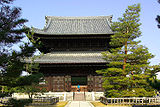- Mokoshi
-
 Yellow: moya; red: mokoshi, white: hisashi
Yellow: moya; red: mokoshi, white: hisashi
In Japanese architecture a mokoshi (裳階・裳層 also pronounced shōkai), literally "skirt story" or "cuff story", is a decorative pent roof surrounding a building below the true roof.[1] Since it does not correspond to any internal division, the mokoshi gives the impression of there being more floors than there really are.[1] It is usually a ken deep and is most commonly seen in Buddhist temples and pagodas (see for example the article tahōtō).[1][2] The mokoshi normally covers a hisashi, a walled aisle surrounding a building on one or more sides, but can be attached directly to the core of the structure (the moya), in which case there is no hisashi.[1] The roofing material for the mokoshi can be the same or different (see for example's Hōryū-ji's kon-dō) as in the main roof.
Contents
Origin and purpose
The name derives from the fact that it surrounds and hides the main building like the cuff (裳裾 mosuso) of a pair of pants.[3] Its purpose was in fact to hide the thick sustaining pillars of the structure, making it look lighter and simpler.[3] It has been used extensively by the Zen sects in various structures of its temple complexes.
Another name for a mokoshi is yuta (雪打 lit. snow strike), hence the name yuta-zukuri (雪打造 yuta style) given to the style of a building featuring it.[2] This name started being used during the middle ages, and stems from the idea that its presence offered protection from snow.[3]
Significant examples
The three storied east pagoda of Yakushi-ji (a National Treasure, see gallery) seems to have six stories because of the presence of a mokoshi between each story.
The first of the kon-dō's (main hall, National Treasure, see gallery) two stories at Hōryū-ji has a mokoshi, which was added in the Nara period with extra posts. These were needed to hold up the original first roof, which extended more than four meters past the building. Hōryū-ji's is the oldest extant example of mokoshi.[3]
The butsuden (main hall) of a Zen temple usually has a mokoshi, and therefore looks like a two story building (see photo above and gallery), although in fact it is not.
Gallery
The following structures all have a mokoshi.
-
Tōdai-ji's Daibutsuden
Notes
- ^ a b c d "Mokoshi". JAANUS - Japanese Architecture and Art Net User System. http://www.aisf.or.jp/~jaanus/deta/m/mokoshi.htm. Retrieved 2009-11-21.
- ^ a b Iwanami Kōjien (広辞苑) Japanese dictionary, 6th Edition (2008), DVD version
- ^ a b c d Shogakukan's Nihon Daihyakkasho, Mokoshi, accessed on November 27, 2009 (in Japanese)
Elements of Japanese architecture Styles Buddhist · Buke · Daibutsuyō · Gassho · Giyōfū · Hachiman · Hirairi · Hiyoshi (also called Hie) · Irimoya · Ishi-no-ma · Kasuga · Kibitsu · Nagare · Ōbaku Zen · Setchūyō · Shinden · Shinmei · Shinto · Shoin · Sukiya · Sumiyoshi · Taisha · Wayō · ZenshūyōA model of Himeji Castle
Building types Roof styles Structural Burdock piling · Chigi · Disordered piling · Engawa · Fusuma · Hisashi · Irimoya-zukuri · Irori · Jinmaku · Katōmado · Katsuogi · Kuruwa · Mokoshi · Moya · Nakazonae · Namako wall · Nightingale floor · Onigawara · Ranma · Shōji (see also washi) · Sōrin · Tamagaki · Tatami · Tokonoma · Tokyō · Tsumairi · ShibiGates and approaches Rooms Furnishings Outdoor objects Measurements Groups See also Buddhist temples in Japan Japanese Buddhist architecture Architectonic elements Mon (gates) Buildings Chinjusha · chōzuya/temizuya · -dō · main hall (kon-dō, hon-dō, butsuden) · kuri · kyōzō or kyō-dō · shoinTō or Buttō (pagodas) Styles Others A-un · kenSchools and objects of worship Major schools Zen schools Nanto rokushū Objects of worship Amida Nyōrai · Benzaiten · Dainichi Nyorai · Jizō · Kannon · Marishi-ten · Shaka Nyorai · Shitennō (Four Kings) · Twelve Heavenly Generals (Jūni Shinshō) · Yakushi NyoraiOther elements Implements kei (ritual gong) · mokugyōOthers bussokuseki · butsudan · Glossary of Japanese Buddhism · Japanese Buddhist pantheon · jingū-ji · miyadera · saisenbakoCategories:
Wikimedia Foundation. 2010.





